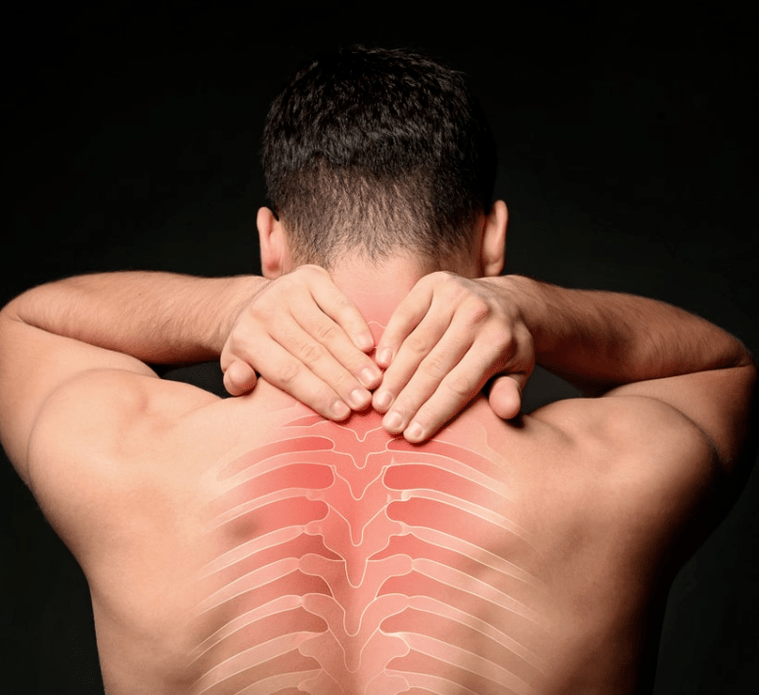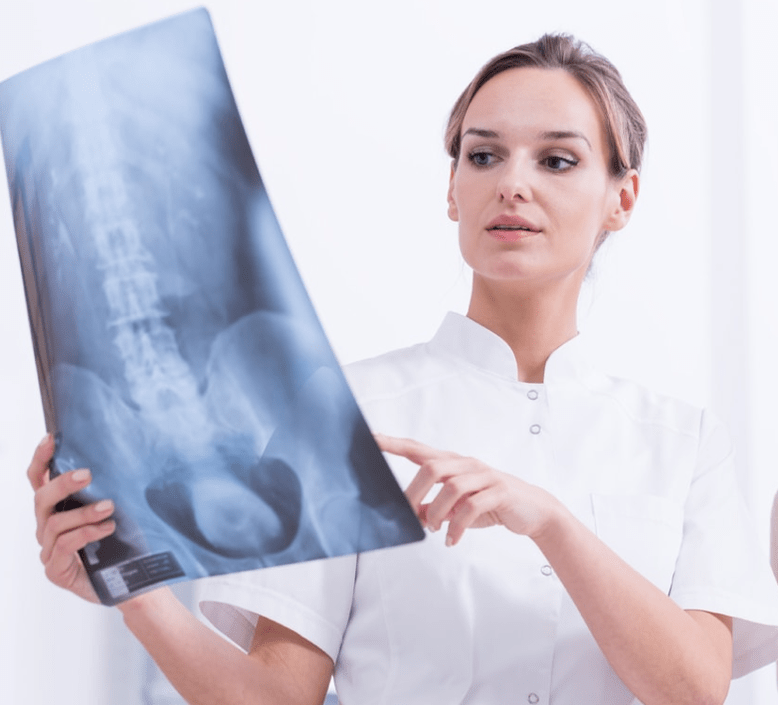
Osteochondrosis is the most common of all spinal diseases. Since osteochondrosis is directly a dystrophic-degenerative lesion on the discs located between the vertebrae, then, as a consequence, this leads to irreversible changes in their structure, as well as the shape of the disc itself, which forms the thoracic spine.
With increasing age of a person, his or her spinal changes increase, and at the age of around 40-45 years, almost everyone suffers from spinal osteochondrosis. By itself, osteochondrosis of the thoracic spine develops more rarely than, for example, the lumbar or cervical spine, because the vertebrae in it are much easier to move than in other vertebral zones. In addition, the back of the chest has a more advanced muscular corset, which supports the spine in the thoracic area much better than the others.
What is thoracic osteochondrosis?
Osteochondrosis of the chestdirectly represents the stratification of the disc between the vertebrae with a simultaneous decrease in its thickness and, as a consequence, pinching of the next nerve endings located in the intercostal zone of the human chest.
However, we note again that because the physiological fixation by the ribs in humans is relatively rigid, the spine in the thoracic region is least prone to osteochondrosis. Thoracic osteochondrosis is a rare phenomenon, for example, cervical or lumbar osteochondrosis.
Typically, with osteochondrosis of the thoracic spine, the pathological process involves the disc between the vertebrae of the thoracic spine, which includes the twelve thoracic vertebrae. But often with osteochondrosis of the thoracic region, pathological changes occur with the upper thoracic vertebrae. There are several degrees of lesions with thoracic osteochondrosis, and further we will consider them in more detail.
Predisposing factors for the development of thoracic osteochondrosis
The exact cause of osteochondrosis of the thoracic region has not been fully determined by modern science. Currently, it is customary to distinguish in medicine the following predisposing factors, or so -called risk factors, because osteochondrosis of the thoracic region occurs in the spine:
- hereditary tendencies;
- excessive physical activity in this part of the spine;
- spinal injuries, such as falls or bruises in the thoracic area;
- changes that occur with age in the intervertebral disc, and cause a decrease in hydration in the disc tissue;
- violation of blood supply in the chest area.
The cause contributes to the disease of thoracic osteochondrosis
Mainly, the development of the disease with osteochondrosis is generally due to hypodynamics, i. e. lack of muscle load, which leads to impaired function of the muscular corset and, as a consequence, increased load on the intervertebral discs and ligaments.
Additional reasons for the development of thoracic osteochondrosis are:
- body hypothermia;
- the presence of chronic stress situations;
- transmitted infections;
- difficult physical labor conditions;
- hormonal disorders that arise in the body;
- violation of metabolic processes in the body;
- the presence of a congenital defect of the spine, i. e. the thoracic region.
During exposure to a combination of these factors, or sometimes one, an irreversible dystrophic-degenerative process develops in the intervertebral discs over time:
- the nucleus pulposus of the intervertebral disc gradually begins to lose fluid, which is secreted by them to provide a lubricating function, which can eventually reduce the damping function of this disc;
- the fibrous ring of the vertebra itself, as the load increases on it, becomes more vulnerable, which in turn leads to its gradual destruction.
Symptoms and signs of thoracic spinal osteochondrosis
The clinical symptoms of thoracic osteochondrosis depend entirely on the following factors:
- patient age;
- the degree of affection of the disease;
- degree of osteochondrosis of the thoracic spine: remission or exacerbation.
The main signs of thoracic osteochondrosis are:
- chest pain in the spine, called dorsago;
- painful damage to the nerve endings of the spinal cord - radiculopathy;
- stomach syndrome;
- cardiac syndrome or changes in the heart muscle, with persistent pain even under the influence of trinitroglycerin;
- pulmonary syndrome, in the form of stagnation in the lungs with signs of hypoxia, i. e. shortness of breath.
An increase in body temperature in patients with thoracic osteochondrosis was not observed, which is also a direct differential diagnostic sign. Dorsalgia in the chest area as one of the main symptoms of osteochondrosis indicates the occurrence of cracks in the annulus fibrosus and deformation of the nucleus pulposus. During the pounding, the pain in this part of the chest only increases, the symptoms increase.
In addition, the hallmarks of thoracic osteochondrosis with compression myelopathy, i. e. deformation of nerve endings, are:
- feeling of "goose bumps" - paresthesia;
- pain along the compression nerve - is a common symptom;
- decreased sensitivity to temperature and from touch;
- Spinal motor dysfunction is also one of the hallmarks.
After discovering such symptoms, you need to see a specialist. The appearance of symptoms in the complex and its intensity is very dangerous. At the same time, it is not advisable to treat the symptoms without eradicating the causes and factors of the disease.
Stages of the disease with thoracic osteochondrosis
Each stage of the disease with thoracic osteochondrosis is characterized by its own pathology, which has only its own clinical signs. Modern medicine distinguishes four degrees of degenerative disc disease in the thoracic region (similar - lumbar and cervical degenerative disc disease) and, therefore, four periods of its development. Let us consider in more detail.
First degree,which is a special feature that cracks appear in the fibrous ring, through which the nucleus pulposus then penetrates. The period of development of the disease with thoracic osteochondrosis is characterized by the following symptoms:
- the appearance of pain in the spine that does not extend beyond the localization of the lesion;
- this pain may be permanent or expressed by the lumbago;
- there may be muscle contraction in the thoracic region, accompanied by pain in the heart area.
Second degreethe development of thoracic osteochondrosis is characterized by the pathological occurrence of increased intervertebral mobility with the following clinical manifestations:
- subluxation appears in the thoracic spine;
- increased pain during movement;
- discomfort appears with prolonged posture.
Third degreecharacterized by rupture of the fibrous annulus and the exit of the nucleus pulposus beyond its limits. During the period of the disease with osteochondrosis of the thoracic spine, intervertebral hernias begin to appear, the clinical signs of which are quite severe. Namely - neurovascular, muscle tonic and reflex -dystrophic.
In addition to the above, for the third degree of osteochondrosis of the thoracic region, the following changes in spinal condition are characteristic:
- poor spinal positioning;
- limitation of mobility of the spinal area, manifested in the form of kyphosis or scoliosis.
Fourth grade- The degenerative process of dystrophy already affects all the structures surrounding the spine. This pathological process involves the yellow, interspinous and other ligaments, and fibrosis occurs on structures around the spinal space. During the course of the disease with thoracic osteochondrosis, a clinically pronounced state of remission is observed.
Complications
With the development of this disease with thoracic osteochondrosis, the development of concomitant complications is possible:
- inflammation of the nerve endings of the spinal cord;
- occurrence of intervertebral hernia;
- development of vascular dystonia;
- development of Schmorl's hernia;
- spondyloarthrosis disease;
- pathological growth of bone growth - osteophytes;
- significant decrease in spinal canal.
It should be noted that the severity of complications arising in thoracic osteochondrosis depends entirely on the rate of progression of the disease process arising and, of course, on the effectiveness of methods for treating osteochondrosis of the thoracic spine.
Diagnostics and methods

In practice, several methods are used to diagnose thoracic osteochondrosis. Of those, the most common is an X-ray examination, the results of which are quite informative. The signs of thoracic osteochondrosis detected in this study were as follows:
- disc contour between fractured vertebrae;
- the edges of the integumental plate acquire a wavy character;
- the intervertebral disc has changed its shape;
- osteophytes appear - pathological growth of bone in the spine;
- the vertebral hook -shaped process has been increased and sharpened;
- the body of the thoracic vertebrae has changed to normal shape;
- the height of the intervertebral disc has decreased significantly;
- a herniated disc between the vertebrae is formed.
In some cases, the method for diagnosing thoracic osteochondrosis of the spine is practiced through X-ray contrast studies, which determine the signs of the following diseases:
- in cases of advanced pathology, the contrast agent fills the intervertebral disc completely;
- with the help of a contrast agent, the contour of the nucleus pulposus can be seen, which is uneven;
- when the intervertebral disc is destroyed, the contrast agent largely penetrates beyond its limits, to the point of penetration into the spinal canal.
Only an accurate diagnosis can determine the right treatment.
Treatment of osteochondrosis
Treatment of thoracic osteochondrosis can be done in one of the following ways, which are used taking into account the diagnostic results of thoracic osteochondrosis, namely:
- conservative-traditional treatment of the spine;
- treatment of chest osteochondrosis with traction;
- surgical intervention.
The treatment of chest osteochondrosis, called conservative, is complex for the treatment of any type of osteochondrosis: medications, physiotherapy, physiotherapy exercises. Non-steroidal anti-inflammatory drugs are intended to relieve pain in the spine, which is known for thoracic osteochondrosis. It should be noted that these drugs eliminate the inflammatory process well, as well as the resulting swelling, helping to reduce nerve root compression. In more complicated cases of breast osteochondrosis, the attending physician may prescribe some additional medications, for example, some painkillers and muscle relaxants that block the appearance of muscle spasms.
When the pain subsides or successfully stops, i. e. during remission, physiotherapy treatment is prescribed, as well as exercise and massage therapy. These are all important components of a comprehensive treatment. One of the main physiotherapeutic tools for the treatment and prevention of this disease is pulsed magnetic therapy using special medical devices for clinical and home use.
Only special parameter magnetotherapy is allowed to be used during exacerbations; there are medical tools to deal with acute and chronic pain. The system is also suitable for the treatment of the lumbosacral and cervical spine.
In addition to the above, traction treatment, i. e. treatment of chest osteochondrosis with special traction, can be successfully used to treat thoracic osteochondrosis. With this method, the paravertebral muscles, tissues and ligaments are stretched, which results in an increase in intervertebral distance. Even one and a half millimeters is enough to reduce swelling, relieve compression, and even relieve tension in the muscles adjacent to the spine. However, the main principle of conservative treatment is its complexity. Treatment should be done over a long period of time and on a regular basis, this is the only way to expect results.
But surgical intervention as a type of treatment of osteochondrosis is only recommended when the above methods to overcome chest osteochondrosis do not give the desired result.





































